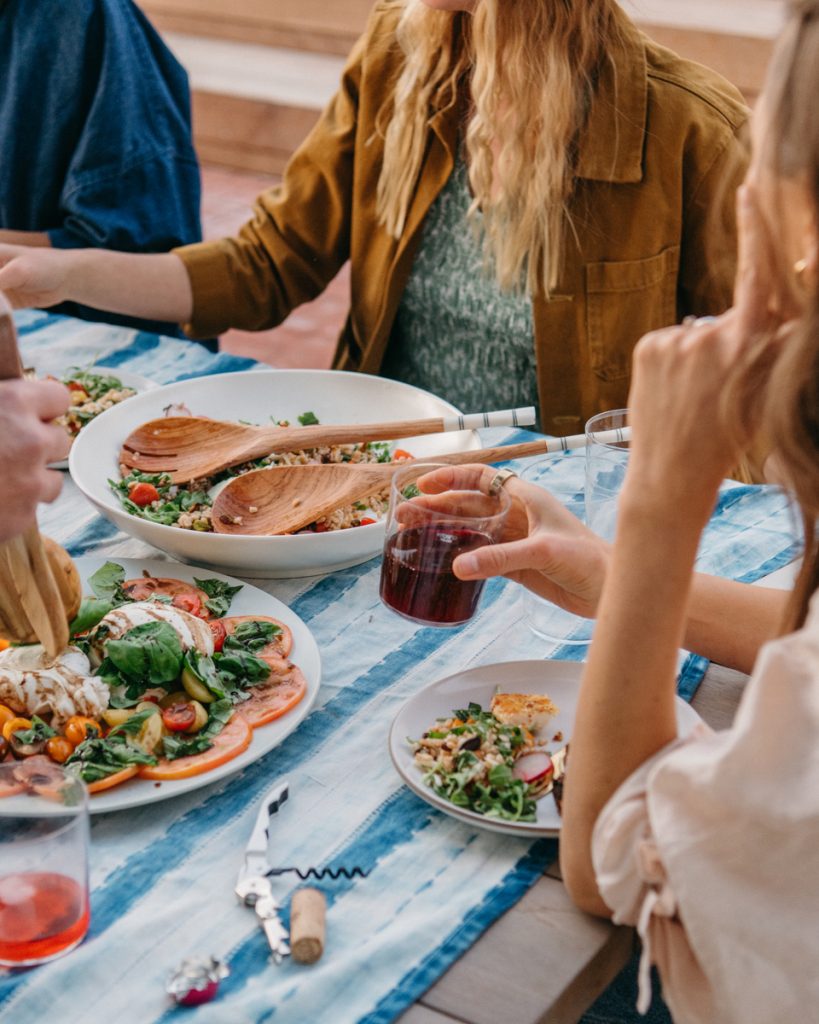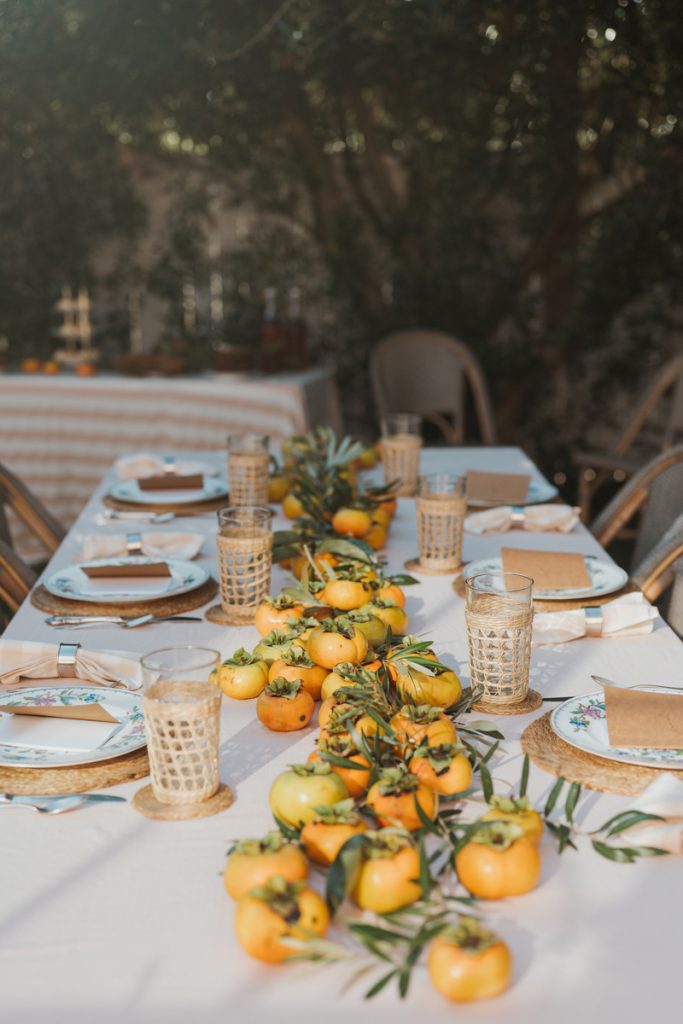[ad_1]
When it comes to hosting a gathering, a few things are non-negotiable. Your favorite people, good conversation, and a menu everyone will remember. But every meal is an opportunity to set the table with intention—even a casual Tuesday night dinner. When we sit down to eat with friends or family, we’re nourishing many different parts of ourselves. We’re satiating our hunger, satisfying our desire for connection, and allowing all of our different senses to be soothed at once.
As one of my favorite writers, M.F.K. Fisher so elegantly said, “Sharing food with another human being is an intimate act that should not be indulged in lightly.”
But we understand too, that when it comes to knowing how to set the table, all the many different etiquette rules and occasions can send your head spinning. And yes, all manner of questions abound. I’m throwing a casual dinner party—how do I fold the napkins? Is there any way I can make my everyday dinners with toddlers feel a little more elegant? Where the heck do I put the salad fork?
Featured image by Michelle Nash.
How to Set the Table: Ideas for Every Occasion
Soup spoons versus dessert spoons and white wine glasses versus red. Your hand goes to place the drinkware with trepidation… Now, is it to the right of the water glass or the left? We’ve been there more times than we can count, and while there are plenty of “rules” to remember, we can appreciate the guidance. Because when it comes to setting the table in style, what’s the point of having beautiful pieces if you can’t let them shine in all their glory?
That’s the fun—and perhaps the beauty—of etiquette. While some may be quick to write it off as antiquated or irrelevant, we like to lean on convention for guidance and inspiration. But, of course, we’re always ones to bend the rules a bit to create space for our creativity. Setting the table is an exercise in balance, after all.
Why It’s Important to Set the Table
Setting the table is akin to getting dressed even when you work from home. It brings intentionality into your day, helping you transition from one moment to inhabiting the energy of the next. And to be clear, the table doesn’t have to match the meal. We love up-leveling the impact of a meal-prepped dinner or leftovers with a freshly-picked bouquet from the farmer’s market or breaking out your best china when friends come over for a meal.
That’s part of making every day a celebration: understanding that when we direct our energy to what’s important, the residual magic is more impactful than we could at first believe.
So if you’re ready to learn how to set the table for everyday dinners, casual gatherings, and formal affairs alike, keep reading—this guide has you covered.
Basic Table Setting
Our weeknight evening meals can often take place in a frenzy. If you’re the parents of littles, then you know that the shuffle from school to sports to pick-up can be a lot. And getting dinner on the table is a feat in and of itself. This is not the time to go over the top (if you even have the energy to consider doing so… ). Instead, we’re keeping things simple and streamlined. For a basic table setting, all you’ll need is a placemat, flatware, a dinner plate, drinking glass, and a napkin.
If you want to—and have the time to—make this meal a little more special, pop a seasonal bundle of flowers in your cart when you do your dinner shopping. Even just a single stem in a bud vase surrounded by a few tea lights can go a long way.
Basic Table Setting Instructions
Just because we’re keeping things basic doesn’t mean you can’t infuse a little personality into your set-up. We love incorporating accents of color here and there with whatever is in our linen drawer. This is not the time to stress over matching sets.
- Cover the table as you see fit. Placemats keep things clean and easy, especially if you’re dining with littles. However, we also love the look of a breezy cotton or linen tablecloth draped over the table. A machine-washable cotton or linen tablecloth means you can throw it in the laundry right after dinner.
- Set your dinner plate in the middle of the table setting or placemat. No charger needed.
- Lay the napkin to the left of your dinner plate. When it comes to a basic table setting, you can either go with this option or place the napkin on top of the dinner plate for a little elegant flair. Bonus points if you incorporate an accent color that’ll pop off your dinner plate.
- Set your flatware. Place the fork to the left of your dinner plate (on your napkin), the knife to the right of your dinner plate, and the spoon to the right of your knife.
- Set the water glass. Your glass goes in the top right corner of your setting, above the knife.
Casual Table Setting
Casual gatherings are centered around intimacy. Versus a more formal affair, you’re likely to have fewer guests—and more often than not, diners who are well-acquainted with one another. Even if that isn’t the case, a casual setting allows you to experiment and explore your own creativity when it comes to the table, adding detail where inspiration calls. Whether it be a custom printed menu, a DIY floral arrangement, or a creative napkin display, know that just because you’re going laid-back doesn’t mean you can’t have a little fun.
With the exception of a few added layers and flourishes, the casual table setting closely mimics the basic setup. However, you may be serving multiple courses during this meal. In that case, you’ll want to incorporate a soup bowl and a salad plate into your setting. As a rule of thumb, only set out the dishes, flatware, and glasses that your menu calls for. There’s no need to go above and beyond (worse comes to worst, it’ll just confuse your guests!).
As for the charger (the decorative plate serving as the base of your dinnerware), you can either opt in or out for a casual place setting. The charger is generally reserved for more formal tables, but if you’d like to accent your plating with one, go ahead. Just be sure to use more laid-back materials, such as rattan or wood.
Casual Table Setting Instructions
- Set a linen tablecloth or placemats. In the case of a casual table setting, we prefer a linen tablecloth. But it’s all up to your own design preferences—elegant placemats can work just as well.
- Lay a dinner plate in the middle of each setting. Next, layer on a salad plate. If you’re serving a soup course, set the soup bowl on top.
- Get creative with your napkins and flatware. The general rules of a basic table setting apply here—go to the left of or on top of your dinner plate with the napkin and your flatware follows suit. However, if you want to change things up and get creative, we love napkins on top of your plates and bundling flatware in drinking glasses. A natural flourish like an herb spring or seasonal flower is a nice accent on top of your napkin.
- Place your water and wine glass. The water glass is in the top right corner of your setting, with your wine glass placed beside and a little up of it. If you’re serving red and white, use both glasses. If not, use just whatever you’re serving.
Formal Table Setting
When it comes to setting a formal table, remember: formal does not equate to stuffy. While it might be the most nerve-wracking of the occasions presented here—formal gatherings often mean a multi-course meal, accompanied by different wine pairings—you’re more than welcome to add a little flair to your table. You may be tempted to opt for matching elements, but we encourage whimsy and bringing an eclectic feel to the setting. This can be achieved through vintage pieces, mismatching wares, and thrifted designs you’ve collected over the years. Just because it’s a formal affair doesn’t mean you can’t weave interest and originality into your table.
Formal Table Setting Instructions
- Opt for a tablecloth. The formal table setting is all about setting a strong, design-forward foundation for the elements to come. A single-toned tablecloth creates a clean landscape for the other components you’ll use to build your tablescape. And to be clear: there’s no need for a perfectly-starched tablecloth. We love the look of little natural texture brings to the table.
- Start with your centerpiece. If you’re using a longer table, go low and long with your centerpiece. Incorporate seasonal fruits, flowers, and herbs to bring color and interest to the table. We love adding a few tea lights for ambiance. The cardinal rule of centerpieces? Be sure guests can see over it and can speak to diners across the table comfortably.
- Lay a charger at every seating. A charger adds layered interest to the table design and creates a natural center point for the multiple plates and bowls a formal setting requires.
- Layer your plates. While you can certainly lay your bread and butter and salad plates to the left of the dinner plate, a formal gathering will likely mean more guests. If that’s the case, and if you want to create added dimension with height, layer your plates in the following order: the dinner plate, followed by the salad plate, the soup bowl (if serving a soup course), and then the bread plate on top.
- Lay a napkin to the left of the charger. To spread your setting horizontally, begin building it outwards by placing the napkin to the left of your dinner plate and charger.
- Add your flatware. Your dinner fork will go to the left of your plate, followed by the salad fork. To the right of your plate, place your knife, with the spoon on the outside. Lay your dessert spoon horizontally above the plates.
- Incorporate place cards. Place cards are a great way to use more of your creative flair. Opt for any seasonal or evergreen design you’d like or keep it simple by folding a small square of card stock in half and writing the guest’s name in legible script, placing it facing their chair. This is not only a great way for guests to find their seats, but to learn the names of those sitting around them.
- Finish off with drinkware. The same rules apply as with the casual table setting. Place the water glass above the dinner knife, with the white wine glass to its right and the red wine glass above, forming a triangle.
[ad_2]
Source link










